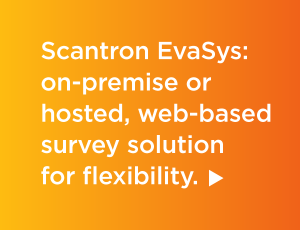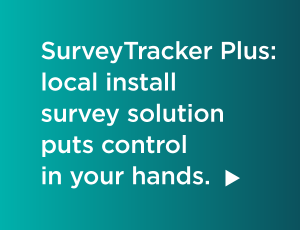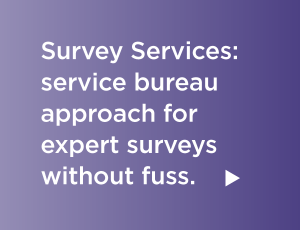 In an increasingly competitive market, deepening engagement with valued clients and with employees has become a core driver of bottom-line performance. The big challenge is how to effectively survey stakeholder groups to gather meaningful feedback needed to improve satisfaction levels, track attitudes, and build stronger relationships.
In an increasingly competitive market, deepening engagement with valued clients and with employees has become a core driver of bottom-line performance. The big challenge is how to effectively survey stakeholder groups to gather meaningful feedback needed to improve satisfaction levels, track attitudes, and build stronger relationships.
For some organizations, the answer appears simple: they choose one of the many high-profile ‘freemium’ web-based survey solutions on the market. While these alternatives provide a free or low cost entry into surveys, the drawbacks are significant.
As many organizations are now discovering, the freemium model’s limitations can work against long-term client insight and satisfaction objectives. For enterprises who want to track and compare survey responses over the course of years, choosing a more robust survey tracking solution quickly becomes a top priority. It’s the only way to gather the type of granular, targeted feedback they need to build deeper and more intimate experiences with their clients and stakeholders.
That’s why many enterprises are now advancing beyond freemium providers with cookie-cutter packages and limited capabilities, and investing in more flexible and feature-rich premium survey software solutions like Scantron’s EvaSys.
Why does premium beat freemium every time? Let’s have a look at four reasons why EvaSys is increasingly becoming the solution of choice.
Distribution Flexibility Drives Engagement & Better Results
Free, web-based survey tools just aren’t geared to the range of audiences and behaviors that many large organizations routinely manage. For example, your clients may represent a broad range of socio-economic groups and you may need to manage a complex network of participants: clients, patients, students, administrators, educators, practitioners, and so on.
As such, a single distribution method like web may not be enough to capture a critical mass of respondents with disparate engagement preferences. And while web-based surveys might be suitable when you can count on reliable Internet, providing paper-based surveys continues to be an advantage in less-connected circumstances.
In addition to connectivity considerations, the type of customer experience also drives the choice of survey distribution method. At the point of service (directly after a customer interaction, for example), there is often a very short window to capture feedback and measure satisfaction. Following up days or weeks later with a web-based survey after the client returns home can lose the critical momentum that paper-based surveys can offer.
After-the-fact surveying can result in poor response rates that deliver smaller and less reliable data samples, ultimately making it much harder for providers to accurately gauge satisfaction levels.
Why premium is the better choice:
- Support for multiple distribution methods (scannable form-based paper surveys, email/web, and mobile) ensures that organizations can tailor their survey approach to reach more of their target audience members and drive higher response rates
- Scannable paper surveys used with plain-paper or OMR scanners provide automated survey data collection that eliminates manual data entry and makes accurate results available almost immediately
- Survey data collected by all distribution methods is stored in a single database to drive centralized analysis and reporting
Better Data Collection & Reporting Drives Deeper Insight & Smarter Decisions
 One of the biggest limitations of freemium survey tools is the lack of reporting depth and customization, especially at the “free” end of the service spectrum. While canned reports can provide a snapshot of stakeholder sentiment, they can be highly restrictive for enterprises with more complex data collection and reporting requirements.
One of the biggest limitations of freemium survey tools is the lack of reporting depth and customization, especially at the “free” end of the service spectrum. While canned reports can provide a snapshot of stakeholder sentiment, they can be highly restrictive for enterprises with more complex data collection and reporting requirements.
Organizations must be able to collect survey data not only from a range of distribution methods (scannable paper surveys, web, mobile, etc.), but also analyze and filter survey data in any manner they choose so they can identify key insights. For example, a large corporation may want to segment its survey audience by asset size, revenue, type of product or service, and industry type, then filter survey results to produce highly targeted reports that reveal key performance insights. These insights drive more informed decisions, such as targeting at-risk customer segments with lower satisfaction levels or poor cross-sell performance.
Another key reporting limitation of freemium survey tools? While they offer some custom reporting at the high end of the scale, they struggle to meet the needs of organizations that want to build a robust report library to support future survey efforts and perform longitudinal analysis that tracks attitudes and satisfaction levels over time.
Why premium is the better choice:
- Capture virtually unlimited demographic information and offers unlimited data collection and filtering to produce any type of on-demand custom report
- Organizations can use a wide range of pre-defined report templates and can also create an extensive library of custom reports for use in future surveys
- Survey data from multiple distribution methods and external sources can be easily centralized in a single database for comprehensive analysis, filtering, and reporting
Demographic Tracking Builds Deep, Long-Lasting Engagement with Survey Audiences
Another major limitation of freemium web-based survey tools is their lack of audience demographic tracking and analysis. While they support basic customer email lists with a handful of audience fields, this provides only a very high-level view of survey respondents and what makes them unique. That might be suitable for a very simple one-time survey, but surveys that drive business decisions need to support a broader and more diverse community of clients and stakeholders. Gathering meaningful feedback on satisfaction levels or attitudes requires a much more granular understanding of audience characteristics and behaviors.
Freemium survey tools typically support four audience fields, a limitation that often requires asking survey recipients for the same demographic information repeatedly. For organizations attempting to track client experiences or satisfaction levels over time, this makes surveys unnecessarily long and increases the likelihood of respondents abandoning their response or refusing to respond at all. This contributes to incomplete survey data and less reliable insight into audience feedback.
Repeatedly asking for the same information also risks alienating core clients and stakeholders, preventing organizations from building more intimate, one-to-one relationships. Enterprises that are more serious about deepening client relationships are beginning to recognize that much more robust support for audience demographics is the only way they can consistently meet—and exceed—client expectations.
Why premium is the better choice:
- Provides support for a wide variety of audience fields, enabling organizations to capture and reuse deep demographic data and build more intimate relationships with survey respondents and stakeholders
- Leveraging existing audience demographics helps to reduce the number of demographic survey questions, ultimately promoting better response rates, more complete data, and virtually unlimited data filtering and reporting flexibility
- Organizations can create fully branded surveys and reports to ensure that key brand attributes and values are reinforced throughout the survey process
Survey & Question Libraries Provide Increased Deployment Flexibility, Control, & Timeliness
 When it comes to surveying customer and employees, organizations require a high level of flexibility and control, yet also want to take advantage of deployment short cuts that can help accelerate survey design and distribution. While freemium survey tools provide certain time-to-market benefits, these benefits are usually basic and can often introduce risk.
When it comes to surveying customer and employees, organizations require a high level of flexibility and control, yet also want to take advantage of deployment short cuts that can help accelerate survey design and distribution. While freemium survey tools provide certain time-to-market benefits, these benefits are usually basic and can often introduce risk.
For example, without an extensive library of tested and validated survey types and questions, organizations can very easily launch surveys that fail to capture the desired audience feedback or introduce bias that affects the integrity of survey data (leading questions, for example). Another time-to-market demand that freemium tools can’t accommodate is automatically sampling smaller groups of respondents to accelerate the feedback process yet still produce statistically valid results.
A major consideration for most organizations is data privacy and confidentiality. Today’s companies contend with more stringent data privacy controls, whether as part of their own privacy policies or because of outside regulation. In these cases, companies may prefer to host surveys and store data within their own IT environment or in a secure, dedicated hosting solution, rather than entrusting it to a more public environment like a free survey tool that makes its profit from advertising revenue.
Why premium is the better choice:
- With a wide selection of survey templates and an extensive library of validated questions, premium solutions to ensure that organizations deploy the right type of survey and capture unbiased, objective feedback
- Unlike freemium survey tools, premium solutions provide the flexibility to host surveys within an organization’s IT environment, while often also providing a secure, hosted option for organizations that don’t want to further burden their IT department with additional software and data storage requirements
- Extensive survey filtering capabilities help enterprises with very large distribution audiences accelerate the feedback process, while also ensuring statistically accurate results
- In addition to extensive question, survey, style, image, and message libraries to speed survey creation, premium solutions typically provide a graphical interface with drag-and-drop capability for even faster survey design—including options to see how surveys will look in all distribution methods
Freemium survey tools and services may continue to satisfy more limited survey demands. But for companies focused on building valued, long-term relationships with large or diverse audiences, premium solutions provide a cost-effective approach that delivers proven competitive advantages.


Social
View our latest posts or connect with us below on Social Media.